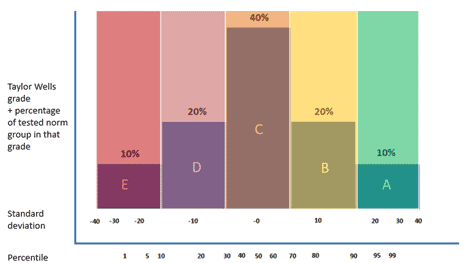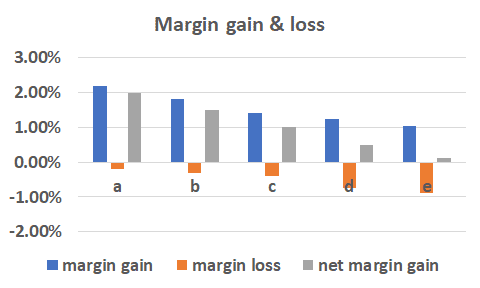
Financial Profitability And How Pricing Teams Can Help Your Business Grow ⬆️
A lot of executives don’t really know what ‘good’ pricing looks like – and struggle to use this to improve financial profitability. It may sound like an incredible claim, given how often executives talk and discuss financial profitability, price, and value at conferences or team meetings.
>Download Now: Free PDF How to Improve Your Pricing Team Performance
However, after reviewing the approach to pricing and value management of over 100 Australian businesses in B2B and B2C markets, most executives use price setting that doesn’t keep up with the market. As a result, they drive down price floors from one market or application to another. Therefore, executives settle for the first price that comes to mind. While copycat competitors add a percentage markup on costs or worst of all, they end up just guessing.
In this article, we’ll show you the real differences between how Australian businesses set and manage prices using research and evidence. What is clear from our research is that highly skilled and knowledgeable pricing teams generate up to 1.5% more profit uplift for their businesses opposite cross-functional teams of generalists using traditional pricing approaches and methods.
What is financial profitability?
First of all, profit and profitability are two different things. Profit refers to the income and revenue that a business receives from its transactions and activities with customers. On the other hand, profitability is a measurement that points out a company’s profit ratio in reference to its size. Without both, businesses won’t thrive.
Profitability ensures the financial health of a business. It also shows you if it is efficient in maximising and capitalising on your resources. Comparing and analysing past and current profitability data also helps predict future targets when making key decisions for the organisation.
To do this, you need to start with an income statement (tracking your profit and loss/expenses over a specific period). This allows you to plan and mitigate cash flow risks and issues moving forward. Since every businessman’s goal is to increase profitability, obviously, a business that has low profitability won’t survive.
So, you might have to look into the organisational design, processes, operations, a self-reinforcing business model, and how well cross-functioning teams are working together. Conversely, assessing product quality is just as important. How can you develop new products that set you apart from competitors? Maybe look into improving your services or adding extra features. Then, couple this with price adjustments to project trajectory and profit goals.
The Impact Of Market Trends On Financial Profitability
Staying attuned to market trends is pivotal for optimising financial profitability. Understanding how market dynamics influence consumer behaviour can significantly impact your pricing strategies.
Firstly, it’s essential to acknowledge that consumer preferences evolve with market trends. Suppose there’s a growing trend towards sustainable and eco-friendly products. In such a scenario, adjusting your pricing strategy to highlight the eco-friendly aspects of your offerings can enhance their perceived value, potentially leading to increased sales and improved financial profitability.
Moreover, market trends often dictate the level of competition. If there’s an influx of new entrants offering similar products or services, a strategic pricing approach becomes imperative. Consider implementing promotional pricing or loyalty programs to retain customers and maintain financial profitability amidst increased competition.
Additionally, technology advancements can reshape market trends. For instance, if there’s a shift towards online shopping, adjusting your pricing strategy to accommodate digital channels can open up new revenue streams. Implementing competitive online pricing and offering exclusive online discounts can cater to the evolving consumer landscape, contributing to financial profitability.
Being responsive to market trends also involves anticipating changes. For instance, if economic indicators suggest a potential downturn, adjusting your pricing strategy to cater to price-sensitive consumers can help sustain financial profitability during challenging times.
A proactive approach to understanding and adapting to market trends is essential for small businesses aiming to maximise financial profitability. Regular market analysis, competitor assessments, and a flexible pricing strategy that aligns with emerging trends can position your business for sustained success in a dynamic business environment.
How does financial profitability support the development of a better business model?
Financial profitability is defined as a company’s profit divided by its expenses. More efficient businesses frequently make more profit as a percentage of their expenses. In contrast, a less efficient organisation must spend more to yield the same profit.
Measuring financial profitability is important because it reflects a company’s reliability and performance. It is the overall profitability of the firm as well as how well it handles its shareholders’ money. When comparing two stocks in the same industry, this is useful. For instance, suppose an investor was comparing two comparable real estate stocks.
How well do leading Australian businesses set and manage prices to drive financial profitability?
An independent study by Taylor Wells, Australian pricing, and talent advisory, reveals industry norms for high-performance pricing teams currently stand at 1.75% to 2% of total revenue and 0.5% at EBITDA for an average pricing team.
*N=857 pricing and commercial employees across most industry verticals – Australia, US, South America, and EU.


There is substantial evidence to show that high-performing and low-performing teams yield substantially different results based on their level of pricing skills, knowledge, and characteristics.
Below is an explanation of each team profile operating in major Australian businesses today:
‘A’ Grade
Less than 1% of Australian companies have an ‘A’ grade or a Six Sigma pricing team. They generate a 3% additional margin uplift on total revenue using sophisticated price strategy, price analytics, and predictive demand. This is an exceptional pricing team driving and informing an excellent forward-thinking price strategy. They achieve their full potential because they have highly skilled and knowledgeable analysts and managers in the team. They also operate in a supportive business culture that understands and practices superior price management methods, embracing a test-and-learn model.
‘B’ Grade
20% of Australian businesses have a ‘B’ grade, a dedicated price management team. This team has an excellent forward pricing strategy. There are some superb pricing skills on the team, but there are a few gaps, diversity issues, and bad hires. Rather than a focus on the strategic aspects of the role, the team gets caught up in administrative and tactical activities. Implementation can be slow and yield average results. There is also ongoing internal resistance/pushback from other departments in the organisation and limited active sponsorship from the executive level. Lastly, profitability is capped at a 1.5% additional margin due to their abilities.
‘C’ Grade
40% of Australian businesses are ‘C’ grade or a fire-fighting pricing team. This team reacts to market changes rather than drives strategy. They have limited executive sponsorship and are set up or positioned incorrectly inside the business. Their performance standards are dragged down by resource issues, limited systems, and bad hiring decisions. Stakeholders are unaware of the differences between pricing approaches and are disengaged from new pricing initiatives. There are lots of problems and issues to fix daily with limited or broken pricing processes that are undocumented. This team typically ends up focusing on maintenance activities, rather than strategic actions. Their ability to drive financial profitability is capped to a .5% additional margin.
‘D’ Grade
20% of businesses have a ‘D’ grade. They are cross-functional teams of business analysts. This team reviews prices on an infrequent basis (usually annually or bi-annually) using cost-plus thinking and methodology. Pricing practices are very tactical and reactive, i.e., correcting some errors in a legacy price list. So, changing the price will cause lots of pushback from stakeholders and customers, while profitability is capped at a .25 to .5% margin. There are no pricing processes and price models, and structures and systems are antiquated and ineffective. Unfortunately, the cause of margin erosion or how to fix it remains a mystery. Because of this, the business faces an 8% margin loss.
‘E’ Grade
10% of businesses are ‘E’ grade, with individuals across the business setting and managing prices without any support or guidance. This could be individual sales representatives or category managers who have discretionary pricing power, yet limited pricing knowledge and skills. There is no centralised competitive analysis and more systems issues. There is also a lack of understanding of price management and advanced price-setting skills. Cost-plus or margin-based techniques set the price. There is also an entrenched commodity mindset that is capping profitability to a .125% additional margin. As a result, a profit downgrade is imminent and the business faces a 9% margin loss each year due to the wrong pricing system and setup.
The chart below shows the financial profitability performance, risks, and net results for high-performing and low-performing teams.

Empower teams to create a pricing culture for financial profitability.
Most of all, a high-performing pricing team is your secret weapon for driving sustainable financial profitability no matter how difficult the market is. While a conservative estimated profit uplift generated by a pricing team is 0.5% at EBITDA. More recently, industry norms currently stand at 0.75% to 1% of total revenue.
Therefore, an increasing number of Australian companies recognise the need for a dedicated pricing function or specialists in the business. As a result, over the past five years, there has been a 60% increase in the number of pricing jobs advertised on job boards in Australia. Now, unlike ever before, Australian businesses are investing heavily in finding and nurturing pricing talent. This drives more complex pricing outcomes while establishing high-performance norms.
However, results indicate the need for a specialist pricing resource is probably underestimated by many executives for a variety of reasons:
-
- Compared to sales, finance, and marketing, pricing is a relatively new practice area.
- There are no past precedents for leaders to refer to and lots of role ambiguity.
- Many executives in charge of pricing have expertise in other functional areas and do not know what proper price management looks like.
- It is commonplace to find managers putting staff forward for pricing roles which often turn out to be completely unsuitable, verging on incompetence.
- Many businesses still rely on standard internal hiring and talent management practices. This overlooks the right people they are looking for.
A Better Business Model to Increase Financial Profitability
A business model is densely related to both strategies and tactics. As Joann Margaretta puts it, “business models are stories.” You must ask:
1. Who are your customers? A robust business model identifies your customers and what they value the most.
2. How do you want to make money while delivering value at the same time? You may have a business model but lack consistency in strategy and tactics.
3. Once you know your target customers, what are the best ways to reach them? How do you build a robust relationship with them? Also, what are your revenue streams and channels?
4. Exactly what are your activities and resources that are aligned with your value proposition? And what are the costs of doing this?
5. Do you have key partners and who are they? Who are your shareholders?
Increasing profitability should address issues across product quality and range, marketing, operations, and pricing. The trouble with most companies is that they become comfortable and complacent when they succeed in sales and production. At times, some even resist change and become risk-averse.
How you respond to a competitor’s business model can strengthen yours. In fact, a self-reinforcing business model should help you plan and decide on risk/factors such as imitation, the efficiency of resources, substitution or customer churn, and possibly disrupting the market. It’s also possible that your competitors will become your partners in the future in value creation.
Below are some of the most common business models:
Subscription Service
A subscription model is used by Netflix and other streaming services, or SaaS (software as a service) where users choose their subscription plans that range from Good, Better, and Best features.
Service as the Product
An example is Uber or Grab where riders are charged by the miles or amount of time they use riding cars. Conversely, there’s a pay-as-you-go model from electricity companies/providers.
Rent a Service/Product
Also known as leasing, this is common in car rental services, housing, and renting equipment or even clothes.
Membership user community
Customers are charged membership fees monthly or yearly for access, usage, and advertising opportunities (such as newsletters.)
Brokerage
Buyers and stores use one platform either physically or virtually (here’s how you can optimise your eCommerce strategy.)
Bundle
This combines a range of services often seen in fast food chains like McDonald’s or streaming services like iTunes. Mobile phone plans also use this model in bundling data coverage, international calls, and pairing with other streaming apps for customers.
Crowdsource
This is often seen in giants like Youtube and Wikipedia where contributors create free content for the public/viewers which they can access broader content.
Freemiums
This is when basic services are offered free for customers and other premium features are charged like Skype, Spotify, and Survey Monkey.
Direct Selling
This eliminates middlemen, wholesalers, and distributors just like how AmWay and Avon do business.

Create productive pricing and commercial teams that know exactly what they need to do to drive strategy and financial profitability.
Considering the price-performance results above, Taylor Wells’ mission is to help leaders unleash the profit potential of their teams in the best way possible.
Some of our clients consult us because they want to find out the skills and training that they’re missing across their pricing and commercial teams. Others want to understand the best way to optimise pricing in their businesses but realise that they don’t have the knowledge and skills to assess their teams’ pricing skills and capability.
Others come to us because they want to make sure they don’t overlook talented people suitable for pricing roles before they launch an external search for pricing talent. While others are looking for ways to generate streams of passive income while running their primary businesses.
Some have re-structuring issues that are confidential or delicate. They need an outside, impartial view of their teams’ skills and capabilities to understand price optimisation in their business.
Taylor Wells TeamBuilder360 is a team evaluation program that ultimately helps you identify where you need to build capability. We help you determine whether or not you need to change pricing approaches based on your teams’ abilities.
Pricing Strategies For Maximum Financial Profitability
In the realm of small business pricing, employing effective pricing strategies is paramount for achieving maximum financial profitability. To enhance your bottom line, it’s crucial to adopt approaches that align with your business’s unique value proposition and market dynamics.
One key strategy is value-based pricing. By determining the perceived value of your product or service to customers, you can set prices that reflect the worth you provide. For instance, if you offer a software solution that significantly streamlines business processes, pricing it based on the efficiency gains for clients can maximise financial profitability. This approach not only justifies costs but also positions your offering competitively in the market.
Another valuable strategy is dynamic pricing. This involves adjusting prices in response to changing market conditions or demand fluctuations. Consider a small boutique hotel adjusting room rates based on seasonal demand. Implementing such flexibility can optimise revenue streams, ensuring financial profitability during peak periods while remaining competitive during slower times.
Additionally, bundling products or services can be a savvy tactic. Offering packages at a slightly discounted rate compared to individual prices can encourage customers to opt for a more comprehensive solution. This not only boosts sales but also enhances the overall financial profitability of each transaction.
In essence, small businesses need to tailor their pricing strategies to fit their unique circumstances. Whether it’s value-based, dynamic pricing, or bundling, aligning your approach with customer needs and market trends is the key to sustained financial profitability. Regularly reviewing and adjusting your pricing strategies ensures you stay responsive to changing business landscapes, fostering long-term financial success.
〉〉〉 Get Your FREE Pricing Audit 〉〉〉
Knowledgeable pricing teams generate 1.5% more profit uplift and financial profitability than average pricing teams with gaps in their pricing capability.
A high-performing pricing team is your secret weapon to driving sustainable financial profitability. More companies are recognising the need for specialised functions around pricing. Over the past three years, we saw a 60% increase in pricing jobs advertised in Australia.
In our experience, it’s not complacency or organisational failure that creates capability gaps. It’s a lack of understanding about evolving price management practices. So, how do you change a pricing function or commercial division while the pricing industry is changing so rapidly? To be frank, the discipline is still relatively new.
But, perhaps these misrepresentations have always been there – no matter how much we talk about price and value. Self-delusion or denial is a default for many people. Perhaps not knowing what good pricing looks like, means we can make do with what we know. Consequently, we receive only the skimpiest feedback on skills and efficiency from managers and teams who also can’t define what good pricing looks like.
For a comprehensive view on building a great pricing team to prevent loss in revenue,
Download a complimentary whitepaper on How to Build Hiring Capability To Get The Best Pricing Team.
Are you a business in need of help to align your pricing strategy, people and operations to deliver an immediate impact on profit?
If so, please call (+61) 2 9000 1115.
You can also email us at team@taylorwells.com.au if you have any further questions.
Make your pricing world class!
Related Posts
Leave a Reply Cancel reply
Categories
- marketing strategy (26)
- Organisational Design (14)
- Podcast (114)
- Pricing Capability (87)
- Pricing Career Advice (10)
- Pricing Recruitment (19)
- Pricing Strategy (292)
- Pricing Team Skills (13)
- Pricing Teams & Culture (25)
- Pricing Transformation (48)
- Revenue Model (25)
- Sales Effectiveness (27)
- Talent Management (7)
- Technical Pricing Skills (35)






